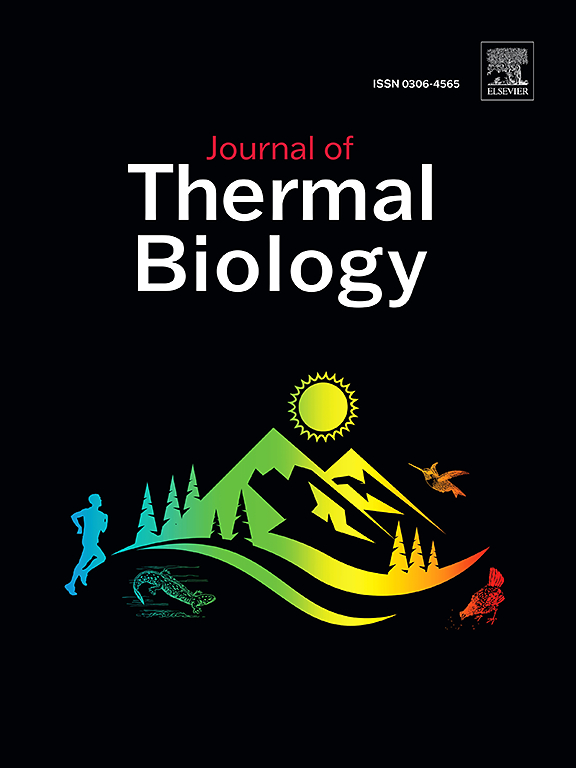Evaluating abnormal cold sensitivity among vibration-exposed workers using hand cold stress testing: A clinical cross-sectional study
IF 2.9
2区 生物学
Q2 BIOLOGY
引用次数: 0
Abstract
Objective
Workers exposed to hand-arm vibration (HAV) commonly experience discomfort in their hands when cold. There is a lack of diagnostic tests for such abnormal cold sensitivity. The main aim of our study was to evaluate the results of cold stress testing in relation to self-reported cold sensitivity among HAV-exposed workers.
Methods
We recruited 225 workers exposed to HAV who responded to a written screening question about cold sensitivity. Cold stress testing was conducted, where the right hand was immersed in 3.0 °C circulating water for up to 60 seconds. The tolerance time for immersion as well as continuous pain ratings on a digital visual analog scale (ranging from 0 to 100 millimeters) were recorded.
Results
The study sample consisted of 208 males (92.4 %) and 17 females, with a mean (SD) age of 40.6 (13.7) years. Among the 190 workers that completed cold stress testing, the mean (SD) tolerance time was 43.7 (16.4) seconds, mean (SD) maximum pain rating 69.8 (27.6) millimeters, and mean (SD) time to maximum pain 38.7 (15.9) seconds. Cold sensitivity was reported by 54 workers (24.1 %). Cold sensitivity was not statistically significantly associated with tolerance time or maximum pain rating, but symptomatic workers had a shorter time to maximum pain (p = 0.018).
Conclusions
Workers who reported cold sensitivity experienced a more rapid increase in cold-related pain, had a tendency towards shorter tolerance time but did not differ in maximum pain ratings. Further studies are needed to determine how to effectively investigate cold sensitivity among HAV-exposed workers.
用手冷应力测试评估振动暴露工人的异常冷敏感性:一项临床横断面研究
目的接触手臂振动(HAV)的工人在受冷时通常会感到手部不适。缺乏对这种异常冷敏感性的诊断测试。我们研究的主要目的是评估与甲型肝炎暴露工人自我报告的冷敏感性相关的冷应激测试结果。方法我们招募了225名暴露于甲型肝炎的工人,他们回答了关于冷敏感性的书面筛查问题。进行冷应力测试,将右手浸入3.0℃循环水中60秒。记录浸泡的耐受时间以及数字视觉模拟量表(范围从0到100毫米)上的连续疼痛等级。结果男性208例(92.4%),女性17例,平均(SD)年龄40.6(13.7)岁。在完成冷应激测试的190名工人中,平均(SD)耐受时间为43.7(16.4)秒,平均(SD)最大疼痛等级为69.8(27.6)毫米,平均(SD)最大疼痛时间为38.7(15.9)秒。54名工人报告有冷敏感性(24.1%)。冷敏感性与耐受时间和最大疼痛等级无统计学意义相关,但有症状的工人达到最大疼痛的时间较短(p = 0.018)。结论:报告冷敏感性的工人经历了更快的冷相关疼痛的增加,有更短的耐受性时间的趋势,但在最大疼痛评分上没有差异。需要进一步的研究来确定如何有效地调查甲型肝炎暴露工人的冷敏感性。
本文章由计算机程序翻译,如有差异,请以英文原文为准。
求助全文
约1分钟内获得全文
求助全文
来源期刊

Journal of thermal biology
生物-动物学
CiteScore
5.30
自引率
7.40%
发文量
196
审稿时长
14.5 weeks
期刊介绍:
The Journal of Thermal Biology publishes articles that advance our knowledge on the ways and mechanisms through which temperature affects man and animals. This includes studies of their responses to these effects and on the ecological consequences. Directly relevant to this theme are:
• The mechanisms of thermal limitation, heat and cold injury, and the resistance of organisms to extremes of temperature
• The mechanisms involved in acclimation, acclimatization and evolutionary adaptation to temperature
• Mechanisms underlying the patterns of hibernation, torpor, dormancy, aestivation and diapause
• Effects of temperature on reproduction and development, growth, ageing and life-span
• Studies on modelling heat transfer between organisms and their environment
• The contributions of temperature to effects of climate change on animal species and man
• Studies of conservation biology and physiology related to temperature
• Behavioural and physiological regulation of body temperature including its pathophysiology and fever
• Medical applications of hypo- and hyperthermia
Article types:
• Original articles
• Review articles
 求助内容:
求助内容: 应助结果提醒方式:
应助结果提醒方式:


